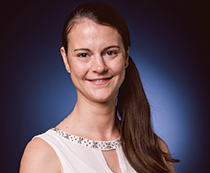The Desert Fireball Network uses a collection of fixed cameras across Western Australia and South Australia that continuously take pictures of the night sky, in search of fireballs. When more than one camera detects a fireball, the combination of observations from different locations can be used to work out where the meteoroid came from, where it was headed, and where the resulting meteorite might eventually be found.
All of that information, and the meteorites themselves, let us piece together the composition and working of the inner solar system, without ever having to leave Earth. This is the team doing it.
Dr Hadrien Devillepoix, planetary scientist, Science Lead
Hadrien wanted to use his skills in data science and computing for something more ‘fun’ than the corporate world. Through an internship at the Paris Observatory, he started developing computing tools to process spacecraft data to discover new asteroids. It led him to a PhD in planetary science with the Desert Fireball Network, developing data reduction tools to make sense of the more than 50 terabytes of data the early network collected every week.
He now helps the rest of the team process the massive amounts of data coming out of the expanded camera network, turning data points into meaningful scientific observations. A particular focus is using fireball trajectories to extrapolate back to where in the solar system the meteoroids came from.
Mr Patrick Shober, PhD candidate
An excellent science teacher in school put Patrick on the path to study physics and engineering, and then an engaging lecturer introduced him to geology. His first research project involved studying meteorites, looking at the alterations occurring at the rock surface to understand the forces that have acted on them and decipher their history. His current research is fundamental to the work of the Desert Fireball Network, doing the orbital modelling to work out where fireballs may have come from in our solar system.
“There are only two ways to figure out what asteroids are made of – you can look at them through a telescope and infer a few things about them, and you can study meteorites on the ground like a geologist can study any rock to determine its composition and history,” Patrick explains. “But you don’t know where it came from.”
“By tracking enough fireballs back to their origins, and finding enough meteorites on the ground to study, you can make connections between the asteroids and the meteorites they generate, and start to work out the composition of our inner solar system.”
Research with supercomputers – tracking meteoroids back through space
Extrapolating the track of a fireball backwards through space to work out where it came from is complicated by the fact that everything in our solar system is constantly moving. With even the best measurements of our planets and their orbits, there are small uncertainties in their exact trajectory and speed. It limits our view back through the solar system to about 60 million years – earlier than that, we can’t tell where the planets were with enough certainty. This only covers the recent geological history of our solar system, as most meteorites that make it to Earth have travelled from their ejection point for millions to tens of millions of years.
“Because we can’t compute an exact trajectory back to a definite point in space and time, we use supercomputing to calculate lots of realistic possibilities,” explains Patrick.
“We create lots of copies of our meteoroid trajectory, representing the range of uncertainties we have in its measurement, and run them backwards through multiple solar systems spanning the range of uncertainties we have in planetary movement.”
Small differences in the starting observations can cause big differences once you extrapolate back, but by calculating thousands of potential orbital trajectories back through time, the probability that a meteorite can be traced back to a specific source can be calculated.
“The best supercomputer in the world can’t give you the exact answer for a meteorite trajectory,” says Hadrien. “But by calculating the probabilities on multiple trajectories, we can narrow it down to the most likely origin.”
Dr Ellie Sansom, geophysicist, Project Manager
Ellie was inspired by an astronaut that visited her school, who told her that if she wanted to be an astronaut, the best thing to do was find something you enjoy, and become really, really good at it, as space exploration needs experts in every field. With an interest in rocks and geology among many other things, Ellie decided to study geophysics.
“I did my PhD with the Desert Fireball Network group. Although I’d studied geophysics, I’d always been keen on space and astronomy, and this blends the two. We’re getting so good at astronomy that we can apply geological techniques to other planets in our solar system, and study space without leaving Earth.”
Ellie now manages the Desert Fireball Network, creating new international opportunities as it expands into the Global Fireball Observatory, with even more cameras in multiple countries covering even bigger sections of sky. On the science side, she analyses the atmospheric dynamics of fireballs and meteoroid entry.
Research with supercomputers – working out what is in a fireball
A surprising amount of information can be gleaned about the meteoroid falling to Earth just from the observations of the fireball burning up in our atmosphere. “The behaviour of the meteoroid is based on very fundamental equations describing atmospheric drag,” says Ellie, “and we can work out how fast it is falling. The major problem is that we don’t know the object’s size, mass, shape, or if it’s strong enough to avoid breaking into fragments.”
Ellie uses supercomputing to create millions of simulated meteoroids with a range of different characteristics, and then calculates how each responds to atmospheric drag, comparing which ones best match the observations of the fireball over time. By matching observations with the myriad of possibilities at every step of the fireball trajectory, she can calculate the initial size and shape of the meteoroid on atmospheric entry, any pattern of fragmentation with estimates of rock strength, and the size of any final meteorite that makes it to the ground.
Knowing the likely size of a fireball as it descends is crucial to predicting where it will land and if it’s big enough to find, so Ellie’s calculations are used to prioritise which fireball sightings may turn into a successful meteorite recovery. Even without recovering a meteorite, the information gleaned about each meteoroid can be combined with its calculated orbit to continue building our picture of the inner solar system.
Mr Martin Cupak, software developer
Martin’s forte is computer systems, making the connections between hardware and software work, especially for fully automated systems. From developing software for instruments on satellites, he turned to automating camera systems, developing the control software for film-based automated cameras and eventually the digital cameras that became the basis of the early Desert Fireball Network.
From building and installing the cameras, Martin is now providing technical support for groups running camera networks across the world as part of the Global Fireball Observatory. He points out: “The observatory is a network of devices and instruments collecting data, all working independently for months at a time. You can’t do that only with scientists – you need the technical people who can operate the network and keep it running too”.
Martin also coordinates the data transfer, processing and archiving of all of the digital photography at Pawsey, as images are periodically collected from the remote cameras. When fireballs are identified, Martin refines the atmospheric models used to predict how local weather conditions alter meteoroid trajectory, allowing more accurate prediction of the final meteorite impact sites.
Dr Martin Towner, field operations chief
Martin grew up with the Thunderbirds and Star Trek, but science fiction rapidly became science fact in his career. After studying physics and working in industry building satellites, Martin returned to research, analysing data from the Cassini–Huygens space research mission to Saturn and developing instruments for several missions to Mars.
His skills in designing instruments that work autonomously in space was turned to developing digital cameras to work autonomously in the desert in 2012, and Martin has been running the Desert Fireball Network’s field operations since then. “I do a lot of the maintenance work, the field work, and the search and recovery operations when we identify a meteorite impact location,” says Martin.
While COVID-19 restrictions on travel are hampering fieldwork, Martin also works on the inner atmosphere trajectory modelling of fireballs, trying to pinpoint their final impact sites. The list of meteorites to search for at a later date is steadily growing.
Research with supercomputers – the path to the ground
Tracking a meteorite to the ground isn’t as easy as following the path of the fireball. As the meteoroids burn up in our atmosphere, they slow down to the point where they no longer glow, disappearing from view. Martin Cupak explains: “During the ‘dark flight’ section of the meteoroid’s trajectory, the last 20–30 km to the ground, we have to consider how the wind will affect its fall”.
Data from meteorological stations all over the world is assimilated in the US and put into a global atmospheric model, so Martin uses that as a starting point. “Once we know when and roughly where a meteorite has fallen, using Pawsey we access the appropriate 500 x 500 km ‘chunk’ of the global model, and run it with the local meteorological data from that time period to get a more precise understanding of the winds at the time, down to a resolution of 1 km. It’s an important part of calculating the final meteorite’s impact site, because winds can easily blow it 5 km off course.”
Real world solutions
The team at the Desert Fireball Network are continually adding to our understanding of the inner solar system, and have classified and calculated orbits for around 2,000 fireballs to date. Seven meteorites have been recovered on the ground, with several tens of meteorites still out there waiting for the next field trip to be discovered.

Dr Ellie Sansom, Geophysicist, Project Manager

Dr. Martin Towner, Field Operations Chief

Patrick Shober, PhD Candidate

Martin Cupak, Software Developer

Dr Hadrien Devillepoix, Planetary Scientist, Science Lead